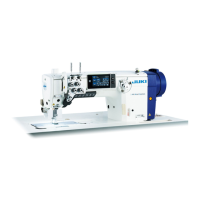– 165 –
Troubles Causes Corrective measures
4. Thread slips o
the needle eyelet
simultaneously with
thread trimming.
①
Thread tension given by the tension
controller No. 1 is too high.
②
Thread take-up spring stroke is too large.
③
Thread trimming is carried out at a
position where no material is present.
○
Decrease the thread tension given by the
tension controller No. 1.
○
Decrease the stroke.
○
To carry out outside-of-material-edge thread
trimming, change
described in
"3-5.
Threading the machine head" p.29
with
the needle thread presser asm. (40034675)
supplied with the unit and turn OFF needle
thread clamp for the beginning of sewing
as described in
"8-7. Adjusting the thread
clamp device" p.107
or temporarily turn
OFF the thread clamp for the beginning of
sewing by means of thread clamp switch
❻
as
described in
"4-11. Custom switch" p.39
.
5. Thread slips o the
needle eyelet at the
start of sewing.
①
Thread tension given by the tension
controller No. 1 is too high.
②
Clamp spring has improper shape.
③
Bobbin thread tension is too low.
④
Thread take-up spring stroke is too large.
⑤
The last thread trimming is carried out at
a position where no material is present.
○
Decrease the thread tension given by the
tension controller No. 1.
○
Replace the clamp spring with a new one or
correct the current one.
○
Increase the bobbin thread tension.
○
Decrease the stroke.
○
To carry out outside-of-material-edge thread
trimming, change
described in
"3-5.
Threading the machine head" p.29
with
the needle thread presser asm. (40034675)
supplied with the unit and turn OFF needle
thread clamp for the beginning of sewing
as described in
"8-7. Adjusting the thread
clamp device" p.107
or temporarily turn
OFF the thread clamp for the beginning of
sewing by means of thread clamp switch
❻
as
described in
"4-11. Custom switch" p.39
.
6. Faulty intertwining of
the needle thread and
bobbin thread at the
beginning of sewing.
①
The bobbin thread clamp pressure is
high.
○
Decrease the bobbin thread clamp pressure.
Refer to
"8-5. Adjusting the moving knife,
the counter knife and the bobbin thread
clamp" p.104
.
○
Hold the needle thread on the material.
7. Thread is not cut
sharply.
①
The blades of moving knife and counter
knife have been improperly adjusted.
②
The knives have blunt blades.
③
Bobbin thread tension is too low.
○
Refer to
"8-5. Adjusting the moving knife,
the counter knife and the bobbin thread
clamp" p.104
.
○
Replace the moving knife and counter knife
with new ones, or correct the current ones.
○
Increase the bobbin thread tension.
8. Thread remains uncut
after thread trimming.
(Bobbin thread
trimming failure
when stitch length is
comparatively short.)
①
Initial position of the moving knife has
been improperly adjusted.
②
Bobbin thread tension is too low.
○
Refer to
"8-5. Adjusting the moving knife,
the counter knife and the bobbin thread
clamp" p.104
.
○
Increase the bobbin thread tension.
9. Thread breaks at the
start of sewing after
thread trimming.
①
The needle thread is caught in the hook.
○
Shorten the length of thread remaining on the
needle after thread trimming.
Refer to
"4-1. Thread tension" p.31
.

